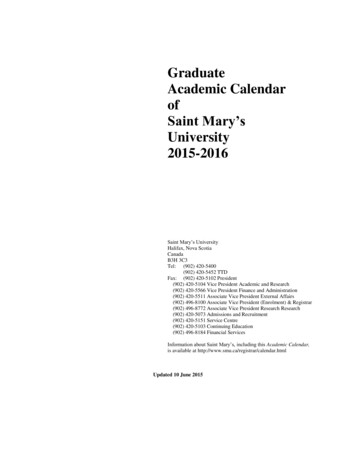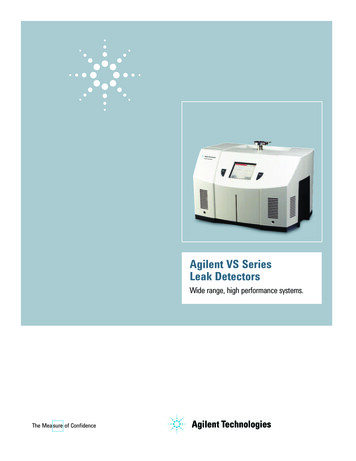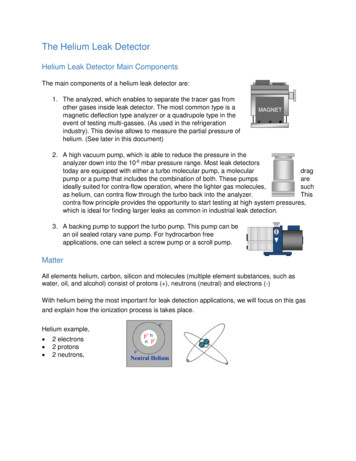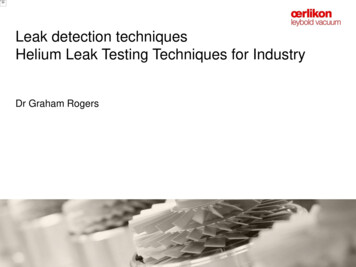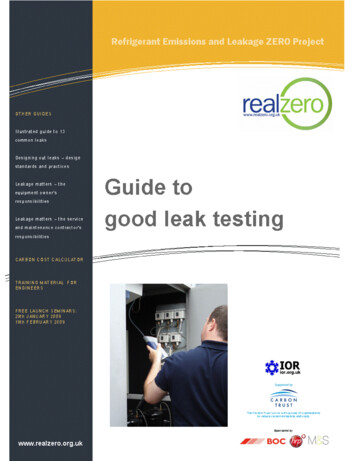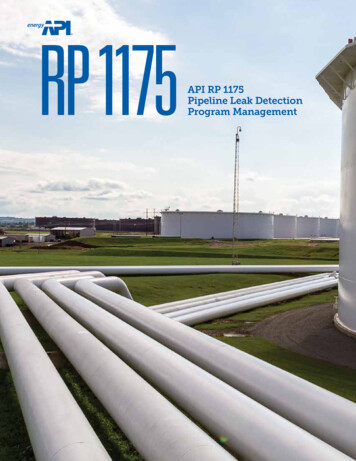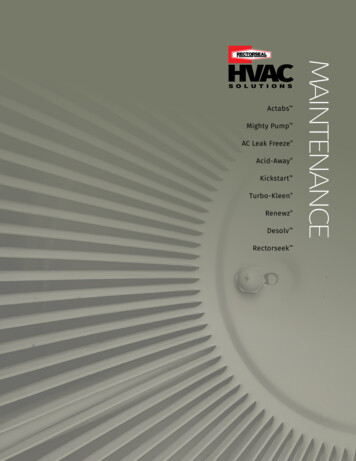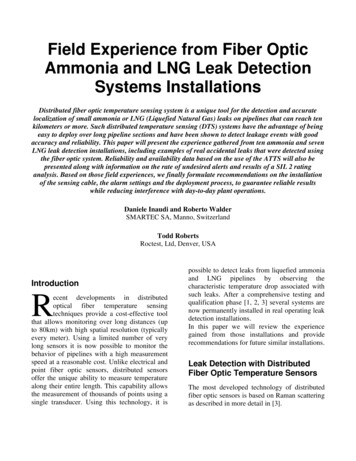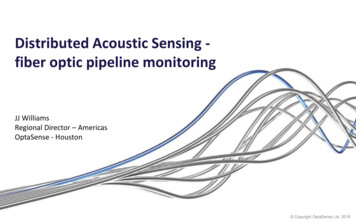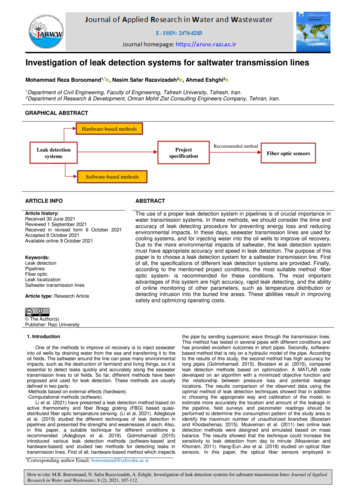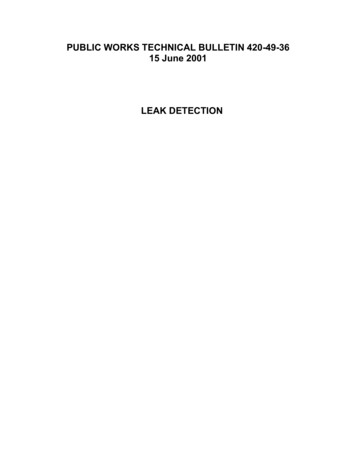
Transcription
PUBLIC WORKS TECHNICAL BULLETIN 420-49-3615 June 2001LEAK DETECTION
Public Works Technical Bulletins are published by the U.S. ArmyCorps of Engineers, Washington, DC. They are intended to provideinformation on specific topics in areas of Facilities Engineering andPublic Works. They are not intended to establish new DA policy.
DEPARTMENT OF THE ARMYU.S. Army Corps of Engineers441 G Street, NWWashington, DC 20314-1000CEMP-RPublic Works Technical BulletinNo. 420-49-3615 June 2001FACILITIES ENGINEERINGUTILITIESLEAK DETECTION1.Purpose. The purpose of this Public Works Technical Bulletin (PWTB) is to transmitcurrent information on active and passive leak detection technology for water, fuel, energy pipeand storage tank systems for implementation at Army installations.2. Applicability. This PWTB applies to all U.S. Army Public Works activities involving theuse of water, fuel, energy pipe and storage tank systems.3.References.a. AR 420-49-02, Facilities Engineering Utility Services, 28 May 1997.b. Army Regulation (AR) 200-1, Environmental Protection and Enhancement, 21 February1997.c. U.S. Code of Federal Regulations (CFR), Title 40, Part 280, Technical Standards andCorrective Action Requirements for Owners and Operators of Underground Storage Tanks(UST), Vo. 53, No. 185, 23 September 1988.4.Discussion.a.The consequences of utility system leaks are more noticeable now than in the pastbecause of increasing requirements for environmental protection and emphasis on energy andwater conservation. Leaks of fuels, other petroleum products and chemicals are a serious hazard.Leaks in water distribution systems waste water, energy and system capacity. Unfortunately it isnot unusual for a water distribution system to have leakage rates of 20%. These factorshighlight the growing importance of leak detection.b.This PWTB provides an evaluation of current leak detection technology applicable towater, fuel and energy pipe systems and provides lessons learned. The lessons provide insightsinto selection of appropriate leak detection technologies, installed either as post-constructionsystem additions or during construction. The attached document provides detailed informationon the leak detection technology and application.
PWTB 420-49-3615 June 20015.Point of Contact. Questions and/or comments regarding this subject should be directed tothe technical POC:U.S. Army Engineer Research and Development CenterConstruction Engineering Research LaboratoryATTN: CEERD-CF-M (Dr. Vincent Hock)2902 Newmark DriveChampaign, IL 61822-1072Tel. (217) 373-6753FAX: (217) 373-7222e-mail: v-hock@cecer.army.milFOR THE COMMANDER:EnclDWIGHT A. BERANEK, P.E.Chief, Engineering and Construction DivisionDirectorate of Civil Works2
ACTIVE AND PASSIVE LEAKDETECTIONTECHNOLOGY FOR WATER, FUEL,ENERGY PIPE AND STORAGE TANKSYSTEMSGUIDANCE
ACTIVE AND PASSIVE LEAK DETECTION TECHNOLOGY FOR WATER, FUEL,ENERGY PIPE AND STORAGE TANK SYSTEMS GUIDANCE1.IntroductionA single gallon of gasoline can render a million gallons of water non-potable. The cost ofeffecting leak repairs is approximately proportional to the amount of trenching needed to accessthe leak. Passive leak detection can provide leak location to within a 6 inch radius of the actualleak location. The use of this technology can save critical time when detecting and locating aleak, and minimize unproductive trenching for repairs.The U.S. Army maintains approximately 20,000 underground storage tanks (UST) andpressurized underground pipelines to store and deliver petroleum and other chemicals. Accordingto the U.S. Environmental Protection Agency, approximately 25% of these are leaking. Theaverage clean up cost of a petroleum leak is estimated by U.S. Army Toxic and HazardousMaterials Agency (USATHAMA) to be 193K, ranging higher where ground water iscontaminated.The U.S. Army also maintains 3,000 miles of steam and High Temperature Hot Water (HTHW)distribution lines. A leak repair in these energy lines can cost in the range of 2-15K per leak,due in large part to the multiple trenching required to locate the source.The objective of this PWTB is to publish lessons learned, based on the evaluation of passive leakdetection technology applicable to water, fuel and energy pipe systems. The lessons provideinsights into selection of appropriate leak detection technologies, installed either as postconstruction system additions or during construction.The U.S. Army Corps of Engineers has reported1 that the most likely technology for reliable andcost effective detection of fuel leaks in underground piping systems is manufactured by ArizonaInstruments Inc., followed by the Tracer Research ALD 2000 system (continuous monitoring),and finally the various cable systems (with the constraint that they must be installed in doublewalled piping systems).Leak detection technologies applicable to water and energy pipe systems were researchedthrough vendor information, but no installed systems were found in the DoD.2. RegulationsThe U.S. Naval Facilities Engineering Service Center has reported upon the pertinent regulationsthat apply to petroleum leaks2. The key points are summarized here, please refer to the original1Timmins, J., Weber, R.A., Hock, V.F., Summary of Findings and Survey Results for LeakDetection Sensors for Water, Fuel and Energy Piping Systems, USACERL Report XX, 10 Sep 1997.2Lefave, J.P., Karr, L., Underground Pipeline Leak Detection and Location TechnologyApplication Guide, Naval Facilities Engineering Service Center, Report UG-2028-ENV, April 1998.
report for a more detailed treatment of the regulatory subject as it applies to airport hydrantsystems, USTs, ASTs, and their associated piping.a.Federal Environmental Protection Agency RegulationsFederal regulations require release detection for underground storage tanks (USTs) and theirassociated piping. Federal regulations also defer the release detection requirement indefinitely(Section 280.10 c and 280.10 d of Ref. 23) for field-constructed USTs, emergency powergenerator fuel tanks, and airport hydrant fuel distribution systems. Release detection methodsthat satisfy the Federal requirement for existing UST systems are discussed at Sections 280.41and 280.43 (for tanks), and Section 280.44 (for piping) (Ref. 23). The options for releasedetection for pressurized piping are:(1)(2)(3)Automatic line leak detectionAnnual line tightness testingMonthly monitoring of soil vapor, groundwater, or the interstitialspace of a double walled pipeline.Automatic line leak detectors must be able to detect leaks of 3 gallons per hour at a pressure of10 psig within an hour. The annual tightness test must be able to detect a leak rate of 0.1 gallonper hour. Other methods are also allowed if they can detect a 0.2 gallon per hour leak rate, arelease of 150 gallons in a month, or are approved by the implementing agency (Ref. 23 Section280.43(h)).b.State RegulationsContacts at the State (or Territorial) regulating offices are available to answer leak detectionquestions. A list of contacts can be found at rnia, Florida, and Texas have special leak detection requirements. California srequirements are governed by the California Code of Regulations, Title 23, Sections 2640 et.seq.Florida s requirements are governed by Florida Administrative Code, Rule 62-761,Underground Storage Tank Systems, and Rule 62-762, Aboveground Storage Tank Systems.Texas requirements are governed by the Texas Administrative Code, Chapter 334,Underground and Aboveground Storage Tanks. Table I provides a summary of the regulatoryrequirements for airport hydrant systems, USTs, ASTs, and their associated piping.c.Regional RegulationsCertain localities may impose regulations that differ from Federal and State requirements.Consult your local EPA office for more information on regional requirements.3U.S. Code of Federal Regulations (CFR), Title 40, Part 280, Technical Standards andCorrective Action Requirements for Owners and Operators of Underground Storage Tanks (UST),Vo. 53, No. 185, 23 September 1988.2
Table I. Regulatory Requirements Summary(from Ref. 4, Lefave and Karr)AirportHydrantSystemsUSTandAssociated Pressurized PipingASTAnd AssociatedPressurized PipingFederal(Deferred)No requirement, unlesspiping is 10 percent oftotal volume, whichmakes the entire system aUST.CaliforniaSame asUST TexasSame asUST Same as tank (deferred for fieldconstructed USTs); After 22December 1998, secondarycontainment (for piping),ANDAutomatic Line Leak Detectorrequired (3 gal/hr at 10 psig). Optionfor approval of alternate releasedetection methods.Hourly (3.0 gal/hr) when pressurizedANDMonthly (0.2-gal/hr)orAnnual (0.1-gal/hr at 150 percentoperating pressure)Hourly (0.2-gal/hr)ANDAnnual Tightness Test(0.1-gal/hr at 150 percent of operatingpressure)Annual Tightness TestFlorida(Currentreg s)Thru1999After1999Florida(Proposed)Same asUST Same asUST In-Line Leak Detector(0.3-gal @ 10 psig)ORQuarterly Pressure TestSame asUST Annual Tightness TestORMonthly Release Detection system3No requirement, unlesspiping is 10 percent oftotal volume, whichmakes the entire system aUST. Same as UST. Same as UST.Hydrant & bulk productpiping (3-inch diameter.): same asUSTs;Other piping upgradewith secondarycontainment.Hydrant & bulk productpiping: Annual tightnesstest.
3.Technology OverviewThere are eight main technologies in use for the detection of liquid leaks, each associated withphysical phenomena which occurs either at a leak site or in the system due to the leak:a.Gas sniffing systems detect changes in chemical concentration, and require the leak toprovide changes in concentration which are detectable above normal, naturally occurringchemical levels.b.Cable systems involve laying a cable in probable leak sites and monitoring forchanges in the cable s impedance, conductivity or (in the case of fiber optic cables) therefractive index, to determine when the cable comes in contact with a liquid.c.Acoustic systems rely on noise produced by turbulent liquid flow through the leak todetect leaks in piping systems. Two sensors mounted either temporarily or permanently to thepipe can locate the leak in relation to the sensors.d.Infrared methods rely on the difference in temperature between the piping systemand surrounding soil to provide a thermal signature which can be observed by special imagingequipment.e.Magnetic flux leakage detection systems (also known as a pigs ) are instrumentswhich identify and record information about pipeline anomalies such as corrosion pits,mechanical damage, dents, mill defects, wrinkle bends, hard spots, and hydrogen blisters. A pigmust be launched with the pipeline completely evacuated and requires special launch andrecovery stations.f.Temperature compensated volumetric testing systems measure the volume of liquidthat must be added to a piping system to maintain a constant pressure, thus providing the flowrate of a leak (or leaks) in gallons per hour.g.Pressure point analysis systems detect pressure waves caused by the sudden onset of aleak in a pipeline.h.Supervisory Control and Data Acquisition (SCADA) systems rely on process controlsensors to detect discrepancies in the performance of the system which could indicate a leak. Onesubset of the SCADA system category (which is often used as a stand-alone leak detectionsystem) is Level Monitoring, which can be used only in closed systems which allow anaccounting system to detect losses. The other SCADA subsystem (which can also be used as astand-alone system) is Mass Flow measurement methods, which rely on various physicalphenomena to obtain accurate measurements of the total mass flow between two points on apipeline. Irrespective of the portion of the SCADA system utilized as the detection system, eachrequires the use of a computer, sensor data acquisition, and an analysis algorithm to evaluate thesensor data and produce a leakage determination.4
Each technology mentioned has a detection sensitivity associated with the system it is used with.These eight technologies are evaluated further in Appendix A in terms of the phenomenaexploited, their system applicability, and their advantages and disadvantages when applied to thedetection of leaks in a buried pipe system responsible for carrying liquids.4.Technology Selection CriteriaImplementation of a leak detection and location (LDL) system is a tradeoff between cost andperformance. Many variables should be considered when selecting LDL equipment. Theseconsiderations are listed in Table II and are discussed in this section. Further information onthese LDL methods is contained in the Appendices of this report.a.Soil Conditions: Soil conditions can affect LDL technology performance. Forexample, tracer gas migrates more quickly in dry, porous soil than in wet soil. Acoustictechniques may also be affected by the type of soil around the pipeline. Tidally influenced saltwater environments pose special corrosion problems for pipelines. When researching leakdetection equipment, always consider the soil conditions.b.Water Table: Some LDL techniques don t work well if the pipeline runs below thewater table or the high tide level. Tracer techniques are less effective if the pipeline is underwater, because leaking tracer gas may be washed away before it reaches a sensor. Or, the tracermay migrate and be detected by another sensor, thus indicating a leak in the wrong location.c.Condition of Pipeline: The age and condition of a pipeline are importantconsiderations when selecting leak detection equipment. Static pressure testing techniquesrequire modern high-quality valves, so that a leaky pipeline can be distinguished from a leakyvalve. Older small diameter pipelines containing sharp bends may be unsuitable for pigging.d.Operations: Certain LDL techniques can be affected by routine operations. Forexample, temperature compensated pressure tests must be conducted when a pipeline is quiet ,which may require temporary suspension of operations. Acoustic techniques can be disturbed byvibrations generated from heavy traffic in the surrounding area. Pressure point analysistechniques may be hampered by fuel facility operations.e.Time Monitoring: Some LDL methods provide leak detection 24 hours a day(continuous monitoring). Other methods provide a snap shot , or assessment of the pipelinecondition at that moment. Regulators may require that a snap shot technique be employed atspecified time intervals to implement an effective leak control program.f.Spatial Resolution: Leak detection and location techniques provide different levels ofspatial resolution. When properly applied, pigging, cables, and acoustic techniques canaccurately locate leaks. However, the accuracy of tracer leak location is a function of the spacingbetween sampling points. Static pressure testing techniques don t locate leaks at all. Sometimesthe best way to solve leak detection problems is to first identify a leak with one technique, suchas pressure testing, and then locate it with another technique, such as tracers.5
g.Leak Rate Resolution: Some leak detection techniques, such as temperaturecompensated pressure testing, provide a volumetric measure of the leak rate. Other techniques,such as product sensitive cables, indicate where fuel has been detected, but not how much fuel ispresent.h.Ease of Retrofit: Most underground piping systems have been in service for manyyears. It is therefore important to address whether a LDL technology can be applied to anexisting pipeline. Some techniques, such as temperature compensated pressure testing, can beeasily applied on most pipelines, new or old. The hardware associated with these techniques isnot an integral part of the pipeline system and can brought to the pipeline by a contractor whoperforms the test. However, these systems can be made a part of the fueling system, if that isdetermined to be cost effective.5.Cost DataTable II. Cost Data for Surveyed Field Installed Leak Location Systems(from Ref. 3, Timmins, Weber and Hock)Leak Detection SystemSoil Sentry 12XP Pipeline andAST Environmental MonitoringSystemCost Data SourceSite Costs PensacolaNAS (Based on26,400')AZI Soil Sentry (Tracer Research Site Costs EllsworthTracer Tightness used on storage AFB (Based on 7908')Tanks - not included in cost data)Installation CostEquip. and Constr.Materials 274,000Maintenance Cost(Annual)Length of Pipline infeetTotal Cost infirst YearTotal Cost PerFoot 30026,400 274,300 10.39 104,000 40,000 3007,908 144,300 18.25 10,750 9951,000 27,245 27.25Soil Sentry 12XP Pipeline andAST Environmental MonitoringSystemManufacturerEstimate (Based on1000') 15,500Tracer Research: ALD 2000ManufacturerEstimate (Based on5,000') 134,941 25,8835,000 160,824 32.16Raychem: Trace Tek (Quote byTracer Research)ManufacturerEstimate (Based on5,000') 113,000 8,0005,000 121,000 24.20PermAlert: PAL-AT LeakDetection SystemManufacturerEstimate (Based on5,000') 49,2465,000 49,246 9.85Vista Research: Model LT100ManufacturerEstimate (Based on1,000') 42,0001,000 42,000 42.00Hansaconsult: TCS TightnessControl SystemManufacturerEstimate (Based on1,000') and Convertedto US Dollars 66,0001,000 66,000 66.00Argus TechnologiesManufacturerEstimate (Based on5,280') 209,4575,280 209,457 39.67This table was derived from questionnaires were to both installations and vendors to determineapplicable current pricing on maintenance, installation, and materials costs for the system typesbeing surveyed. Table II illustrates the relative breakdown of the cost data obtained. Vendorswere supplied with a hypothetical piping system 1000 ft long, carrying JP-8 in a single wall pipe6
buried 4 ft. beneath grade. DoD installations were asked to include similar system descriptionswith installation and maintenance cost data for their individual systems.6.Implementation GuidanceTo achieve sufficient performance from a leak detection system, the pipeline should first beverified for integrity before having a continuous monitoring system installed and tested. The leakdetection system must also be relatively maintenance free and inexpensive to operate. None ofthe systems surveyed or researched provide the optimal level of leak detection on their own.Leak detection in underground piping systems is a multifaceted problem, which requires severaltechnologies to achieve a satisfactory solution.The aspects of leak detection which are and will continue to be the most critical are leak locationand magnitude. A highly sensitive system which monitors infrequently does little to protect theuser from the high costs resulting from a major discharge. A system which monitorscontinuously but is only able to detect major discharge events puts the user at the same risk level.Of the leak detection systems investigated, the most promising technology for reliable detectionof fuel leaks in underground fuel piping systems appears to be the gas sniffing systems. Thistechnology has proven its ability to detect numerous hydrocarbons from natural gas, hydraulicfluid, or JP8. However, the system is not applicable to water or energy pipe systems, and currentsystems are susceptible to water invasion.The AZI leak detection and location system seems to have a good potential. It provides sufficientsensitivity to detect smaller leaks and has the ability to continuously monitor the piping system.The AZI system can also provide leak location to within 10 ft. with 20 ft. well spacing. The AZIsystem could be feasibly made impervious to water by the addition of the Argus Technologiesproprietary sensor tube, which is selectively permeable. Because the AZI system draws avacuum on the sensor tubing, the rate of diffusion of concentrated hydrocarbons could beincreased enough to reduce the idle time required, and still provide a system that continuouslymonitors the site.Tracer gas systems also have good potential. These systems are suitable for intermittent pipelineintegrity tests and do not depend on prior knowledge of the pipeline condition. These systems arebased on the detection of a unique marker gas introduced into the product carried in the pipelineand detected through gas chromatography. They are not useful for potable water piping systemsdue to the toxicity of the marker gas.The technology used in cable systems appear to be useful for both energy pipe systems and newpotable water systems which incorporate double wall piping. There are also cables available forthe detection of hydrocarbon liquids, which makes this technology applicable to fuel, water, andenergy pipe systems.Table III lists the various leak detection and location technologies discussed in this bulletin, andindicates their relative suitability to various field applications under different conditions.7
Table III. LDL Suitability to ApplicationUtilityInfraredMagnetic Flux LeakageTemp. CompensatedVolumetricPressure Point AnalysisSCADAXXXXXXXXXX XGravelSandXX X X X X XXX X X X X XX X X X XX X XXX X XX X X X XX X XX X XXCast IronXXXXXXConcreteXXXXXXWater TableClayBackfillVariesalAbove PipeMaterie0 – 10 psiVariesAbove PipeBelow PipeClayGravelSandAluminumAbove 10 psi0 – 10 psiVariesAbove PipeBelow PipeClayGravelSandSteelPlasticCopperTransiteX X X X X X XX X XX X X X X X X X XX X X X X X X X XX X XXXX X X X X X X X X X XX X X X X X X X XXXX X X X X X X X X XX X X X X X X X XX X X X X X X X X X XX X X X X X X X X XX XPressurWater TableAbove 10 psiBackfillBelow PipeAcousticalClayCableMaterieGravelGas SniffingCast IronLDL TechnologyPressurWater TableSandBackfillCopperMaterialeSteelWater TableAbove 10 psiBackfillVariesPressurMaterialSewageBelow PipeHigh Temp Hot WaterAbove PipePetroleum0 – 10 psiPotable WaterX XX XX X X XX X X XX X X X X X X X X X XX X X X X X X X X XX X X X X X X X XXX X X X X X X X X X X X X X X X X X X X X X X X X X X X X X X X X X X X X X X X X X8
APPENDIX ADetailed Technology Descriptions
Detailed Technology Descriptions1.Gas SniffingTechnology: Electro-chemical sensors are calibrated to background concentration levels of theparticular compound of interest. In some situations this compound can be an additive to theliquid to make detection feasible. Sensors are located or transported to a suspected leak location,where readings are taken and compared with threshold values to determine either a leak or no leak condition.Use: These sensors are commonly used with Volatile Organic Compounds (VOCs) whichproduce highly localized concentrations of vapor when a leak occurs. They can also be utilizedwith tracing gases, which are introduced into the system.Installation: Some gas detection equipment can be installed permanently and remotelymonitored, however, the most frequent configuration is a hand-held unit which is used insurveys.Advantages: This system is good for some liquids, such as petroleum products, which producevapor that can permeate through the soil covering the pipe system and produce an area ofconcentration sufficient for detection around the leak location.Disadvantages: Leaks of liquids with varying ambient concentrations, such as water, can easilybe masked by the background noise. It is also not possible to chemically detect the presence of awater leak without adding a marker compound to the liquid. This would not be acceptable forpotable water distribution systems, as the tracing additives are sometimes toxic.2.Cable SystemsTechnology:(1) Impedance Mismatch - A cable with a permeable outer shield is excited with aknown frequency. Because the dry cable has a known impedance and length, when a leakchanges the dielectric properties at a particular location within the cable, it creates an impedancewhich can be located along the length of the cable by signal attenuation and phasemeasurements.(2) Conductivity - Two conductors (generally stainless steel) are woven into aspecially treated cable or ribbon. When a conductive liquid forms a continuity path between thetwo wires, a leak condition is indicated and can signal an alarm.A1
(3) Refractive Index - A fiber optic cable is given a coating that interacts with acontaminant. In the presence of the contaminant, the light passing through the fiber is affected,providing a means of detecting and locating the contaminant.Use: This technology is used to detect aqueous leaks or (with special polymers) leaks of fuel,solvents, electrolytes, acids, and bases. The cable can be installed during construction in limitedaccess applications, or, as in the case of computer room floors and other accessible areas,installed after the fact.Installation: The cable is installed in locations where leaking fluid is likely to accumulate. Thecable is run along the bottom annulus of double walled pipe and terminated at monitoringstations. For area applications, the cable is laid in a serpentine pattern. In multi-branch pipesystems, individual cables can be run from branching junctions.Advantages: This system can be sensitive to different types of liquids and can be easily installed.It can be used in piping systems as well as in storage tanks. The system presents a leak or noleak indication.Disadvantages: After exposure to water or fuel, the cable may need to be replaced. Systemdesign allows for false indications depending on initial designed sensitivity.3.Acoustic MethodsTechnology: Acoustic leak detection methods rely on piezoelectric transducers to translatepressure waves generated by fluid escaping the piping system into an electrical signal. Thesystem generally consists of a piezoelectric (a crystalline material which produces a voltagepotential when stressed) transducer and an amplifier/signal conditioning unit. The operator thenmakes a leak or no leak determination. Research is currently investigating the permanentinstallation of transducers on a piping system at specific locations to continually monitor thesystem s condition.Use: This technology can be applied to any system which is carrying fluids under pressure.Installation: For permanent or semi-permanent installation, transducers are connected to pipingjunctions acoustically via waveguides (metallic connections which conduct vibrations efficientlyfrom the pipe to the transducer). The monitoring system then acts as either a data logger or aremote unit, both of which maintain a record of the acoustic activity in the pipe system withinacoustic range by storing the acoustic signals received above a set threshold in either volatilememory or by transmitting them to a central computer. Portable units are used in a search patternover the piping system, which may include direct acoustic coupling to the system where it isaccessible through manholes or vents.Advantages: Leak location can be determined to within several feet or even within fractions ofan inch, depending upon the location of the pipe and its surroundings. Because the system can beused to scan a piping system, the cost to detect a leak in a large system is only dependent on theman-hours required to cover the system.A2
Disadvantages: The system can give false positives due to flow noise around valves and othergeometry changes. The system can also give false negatives due to noise interference from thesurroundings. Systems which depend upon operators to evaluate the signals require anexperienced operator.4.Infrared ImagingTechnology: Infrared inspections are performed with a video camera capable of recordinginfrared radiation. The camera records the temperature differential and the images are processedto show the different temperatures in a color spectrum. Data can be videotaped for future reviewand processing.Use: These systems are generally used on piping systems which can produce significant thermalsignatures through several feet of earth. This limits them to use with piping systems whichtransport liquids significantly above the surrounding ambient ground temperature, such asheating water or steam.Installation: These systems are used for surveys only. When conditions permit, the system orsuspect locations within the system are scanned for leak indications.Advantages: The advantages of this system are that it can be used to scan large areas at a timeand does not require any excavation. The infrared technique is especially useful for surveyingheating and cooling distribution piping systems.Disadvantages: The disadvantages of this process are that it cannot be used for any pipingsystem that does not present a temperature differential.5.Magnetic Flux Leakage (Pigging)Technology: Magnetic flux leakage detection is done with instruments which identify and recordinformation about pipeline anomalies such as corrosion pits, mechanical damage, dents, milldefects, wrinkle bends, hard spots, and hydrogen blisters. Magnetic flux is sent into the pipe bythe pig, and anomalies cause leakage of the magnetic flux into the ground. Data is recorded forfuture review and processing.Use: These systems are only used for piping systems which are made of steel or cast iron.Anomalies can be located with an accuracy of 0.1% of the distance measured, and theminimum detectable pit ranges from 5 to 10% of the pipe wall thickness.Installation: These systems are used for surveys only. The magnetic tape produced by the pig isexamined for conditions associated with leaks.Advantages: The advantages of this system are that it can be used to scan large areas at a timeand does not require any excavation.A3
Disadvantages: A pig must be launched with the pipeline completely evacuated and requiresspecial launch and recovery stations. Pipeline diameters and bend radii must be large enough toaccommodate the pig.6.Temperature Compensated Volumetric TestingTechnology: Temperature compensated volumetric testing systems measure the volume of liquidthat must be added to a piping system to maintain a constant pressure, thus providing the flowrate of a leak (or leaks) in gallons per hour. The temperature compensation is important, becausethermally induced volume chang
LEAK DETECTION 1. Purpose. The purpose of this Public Works Technical Bulletin (PWTB) is to transmit . L., Underground Pipeline Leak Detection and Location Technology Application Guide, Naval Facilities Engineering Service Center, Report UG-2028 . (in the case of fiber optic cables) the refractive index, to determine when the cable comes in .
